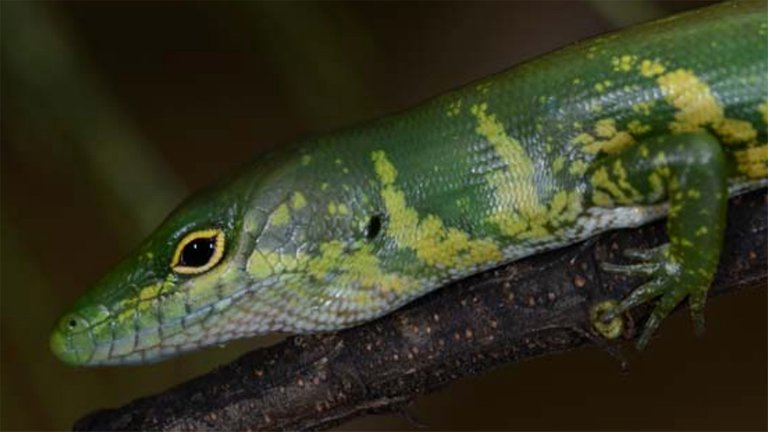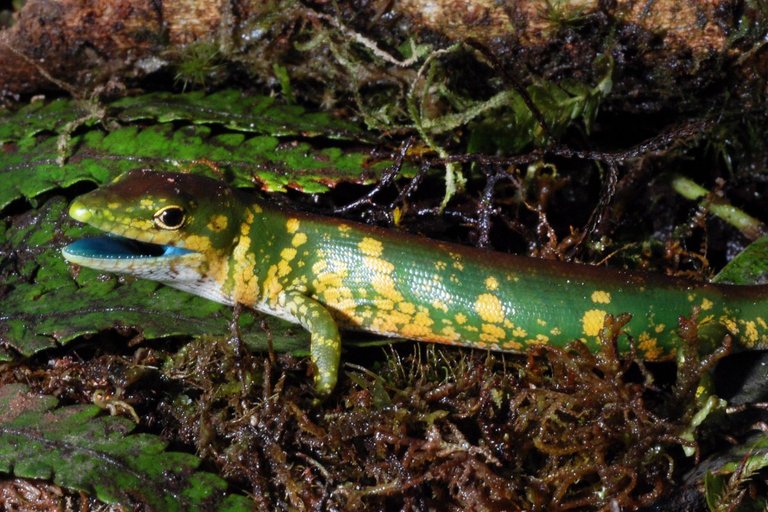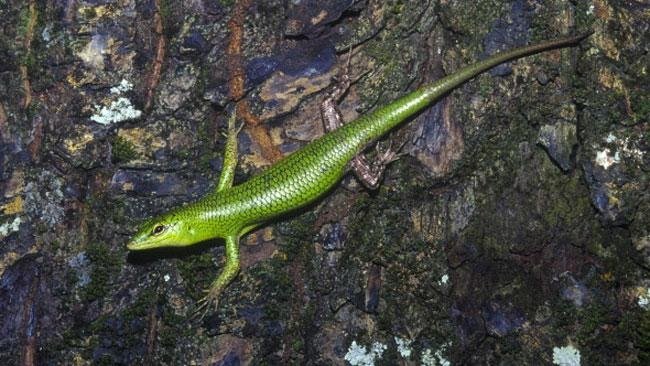Skinks are fairly common lizards in many parts of the world and are really cool animals to stop and observe. Watch one long enough (or startle a lizard by accident!) and you may see them exhibit an incredible defense mechanism known as autotomy. Also called self-amputation, autotomy is the process by which these animals will shed or "drop" their tail, allowing them to escape a predator's grasp with their lives (and they can even grow their tail back!), leaving the wriggling appendage behind as a distraction. However, were you to see a skink in New Guinea lose its tail, you might witness something very unusual: instead of red blood at the stump, some species have blood that is virulently green.
Appropriately named green-blooded skinks, the green blood (and bones, tongues, muscles, mucous membranes) of these lizards is unique for more reasons than just its odd color. While the red color of most animal's blood is the result of hemoglobin (oxygen-carrying pigment in red blood cells), this green shade comes from a bile pigment known as biliverdin. The large amount of biliverdin in their blood plasma actually completely masks the red color of the hemoglobin! Our own bodies produce biliverdin as well, but there is a problem: in high concentrations, it becomes highly toxic. When most animals (including humans) produce biliverdin, it is excreted into the intestine where it is eliminated before it can reach toxic concentrations. In humans, a high concentration will cause jaundice, but this concentration is 40 times lower than that found in the green-blooded skinks...and they appear to suffer from no negative effects of their super toxic blood!

So what would drive an animal to evolve such toxic blood? Biologists have offered up varying theories, often speculating that their blood may make them inedible to predators (or even serve as an extreme form of camouflage). However, this hypothesis is not supported by the evidence; feeding trials studying New Guinea birds and snakes have revealed that the skinks are completely edible, even with their toxic blood.

More plausibly, some biologists speculate that the blood may serve as a different form of protection. Blood parasites (such as malaria) are common in these lizards and extremely debilitating, and the toxic blood may help control the proliferation of these parasites.
More recent experimental work on other animals has suggested that bile pigments, including biliverdin, may act as antioxidants. These protect the body from damaging molecules known as free radicals and have an important anti-inflammatory effect. Source
Skinks are one of the most diverse groups of lizards, and currently 5 species of green-blooded skinks are known to science. All 5 of these species were placed in the same genus, Prasinohaema (Greek for, you guessed it, "green blood"), but there was one big problem with the classification: these skinks were remarkably different from one another. In fact, green blood seemed to be one of the very few characteristics they actually shared between them. Genetic research conducted by biologists at Louisiana State University created an evolutionary tree of more than 50 species Australasian skinks and compared thousands of genetic markers. The study has definitively concluded that these species are not closely related. More interestingly, the green-blooded train has arisen at least 4 times independently! Source

To fully understand how the green-blooded lizards evolved this bizarre condition, we would need more in-depth studies of the specific gene mutations responsible. But now that we know that it has evolved repeatedly it gives scientists more power to disentangle the reasons why. What’s more, it suggests that there is indeed an underlying adaptive advantage for the retention of high levels of biliverdin, as it would be extremely unlikely for such an unusual condition to evolve multiple times by chance. Source
So why should we care? We already know that biliverdin plays a role in several crucial health concerns in humans involving inflammation (like septic shock and wound healing). The evidence of high biliverdin concentrations in these lizards may reveal benefits that could be applied to our own health!
Article Link: https://www.independent.co.uk/news/science/lizards-green-blood-scientists-unsure-biliverdin-jaundice-biology-a8357396.html


Hey there! Nice to see you back on Steemit!
Hey! Good to be back! Took a hiatus while I was job searching and getting settled in my new place, but I have checked in from time to time!
I am glad to finally see another post from you.
The diversity of life is amazing, beautiful, and we are an integral part of it. I have realized that all life is one immortal organism, and it's evolutionary complexity, while baffling and ineffable due to our incapacity to even grasp it's full panoply, is our actual nature. The first living thing passed on it's life force when it reproduced, and every subsequent generation has similarly arisen from the living components passed to it from it's forebears - an unbroken living chain of cells, seeds, and spores that we exist within and pass to our posterity in the same way.
Thanks!
Hi, thanks for the post! I included a link to it in my daily Science and technology digest, and you'll get a 10% share of that post's rewards.
Good to see you back around here! I had no idea that there was such a thing as the green-blooded skink. It would be very interesting to see testing done for biliverdin in people suffering from arthritis, unless there are testing results or studies already done. Seems like we could probably devise a new treatment.
Learning something new every day, thanks to people like you, is like a magical potion that keeps the mind fresh and young. Thank you.
Love to share my passion for reptiles (and animals in general)! Hope to share more frequently going forward!
Congratulations @herpetologyguy! You have completed the following achievement on the Hive blockchain and have been rewarded with new badge(s) :
You can view your badges on your board And compare to others on the Ranking
If you no longer want to receive notifications, reply to this comment with the word
STOPDo not miss the last post from @hivebuzz: